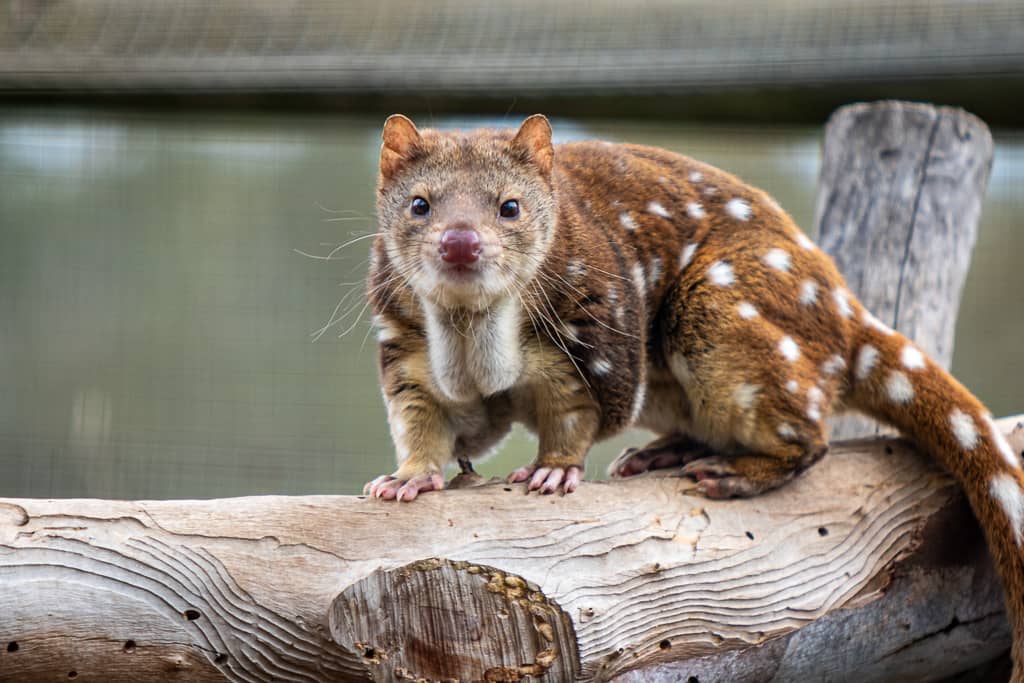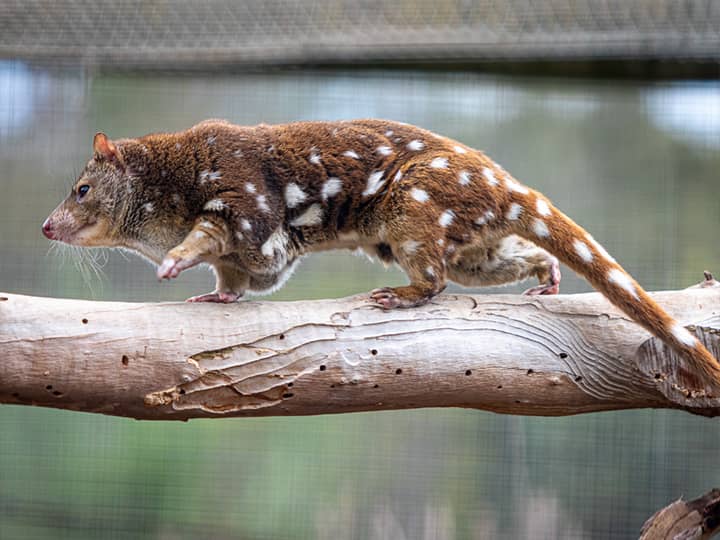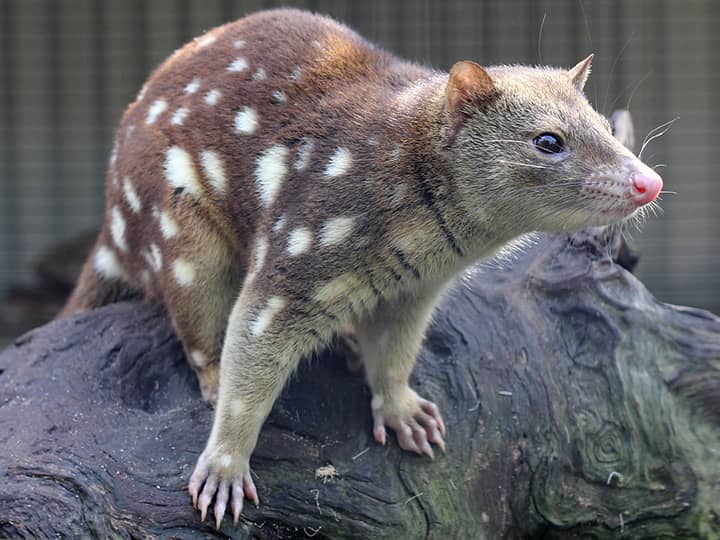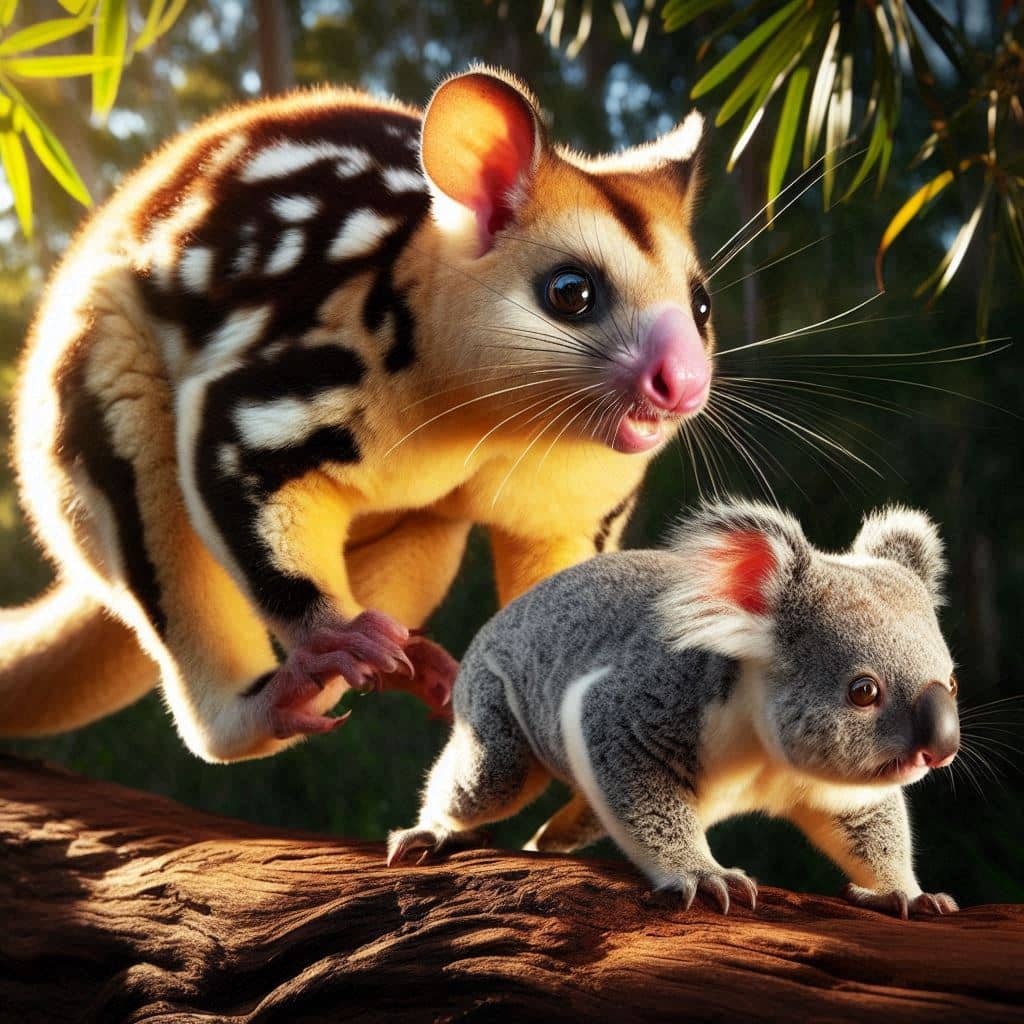Quolls as Predators of Koalas
Quolls are considered one of the minor predators of koalas since their koala hunting is not well-documented. They are opportunistic hunters and prey on young koala joeys or sick koalas. Quolls are the second largest marsupial carnivores after the Tasmanian devils on the Australian continent. But they are smaller in size than koalas. The largest species of quolls in Australia (spotted-tailed quoll or tiger quoll) weighs around 7 kilograms while large male koalas weigh around 15 kilograms. Therefore, their smaller size allows them to target only small-sized or juvenile koalas who are also very small, fragile, and vulnerable.

| Quolls | Facts |
|---|---|
| Koala Hunting | Rarely |
| Predation | Nocturnal |
| Hunting Domains | Ground and Trees |
| Size | Up to 7 Kg |
| Mobility | Up to 7 km |
Just like koalas, quolls are also arboreal mammals. Therefore, they are capable of hunting in the trees as well. As a result, koalas are not safe from quolls in the trees. Furthermore, quolls are fast, agile, and clever predators while koalas are sluggish, lazy, and lack common intelligence. Interestingly, both quolls and koalas are active at night. Quolls have laser-sharp teeth and claws which help them to kill and consume their prey quite easily. Above all quolls have a perfect sense of smell through which they can easily detect their prey.

In Australia South East Queensland, Northern New South Wales, and Victoria are the key regions where quolls and koalas' live together. Therefore, most of the possible predation by quolls takes place within these regions. The spotted-tailed quoll is the largest of all the quolls and can hunt koala joeys has its significant presence throughout these regions. Other species of quolls that are common in these regions include Northern quolls and Eastern quolls. But these two quolls are not as big as spotted-tailed quolls, therefore, the predation of koalas from these two species of quolls is very low.

Quolls have a diverse diet and consume a great variety of animals. Among their 54 percent prey include medium-sized mammals such as bandicoots, rabbits, possums, etc. 30 percent insects and invertebrates, 15 percent include bird species, and the remaining include scavenged food. Quolls can also travel long distances and statistics reveal that at night they move up to 7 km. This makes them mobile predators. Koalas are not the main diet of quolls but as mentioned earlier quolls can opportunistically make koala joeys as their meal.

| Food Type | Percentage of Diet |
|---|---|
| Medium-sized Mammals | 53.9% |
| Insects and Other Invertebrates | 20-30% |
| Birds | 10-15% |
| Reptiles and Amphibians | 5-10% |
| Scavenged Meat | Varies |
Since quolls are native animals of Australia, they easily qualify as the indigenous predators of koalas. Both animals are living on the Australian continent for millions of years. However, due to habitat loss and other unfavorable environmental factors, the population number of quolls is also declining. For example, the population of the largest spotted-tailed quoll has declined by almost 80 percent which makes them an endangered animal on the Australian continent. Lastly, quolls are not considered as a predator that threatens the existence of koalas.
| Rank | Taxon |
|---|---|
| Domain | Eukaryota |
| Kingdom | Animalia |
| Phylum | Chordata |
| Class | Mammalia |
| Infraclass | Marsupialia |
| Order | Dasyuromorphia |
| Family | Dasyuridae |
| Genus | Dasyurus |
| Species | Dasyurus maculatus |
References
- Glen, A.S. and Dickman, C.R., 2006.Diet of the spotted-tailed quoll (Dasyurus maculatus) in eastern Australia: effects of season, sex and size.Journal of Zoology, 269(2), pp.241-248.
- Glen, A.S. and Dickman, C.R., 2008.Niche overlap between marsupial and eutherian carnivores: does competition threaten the endangered spotted-tailed quoll?Journal of Applied Ecology, 45(2), pp.700-707.
- Claridge, A.W., Paull, D., Dawson, J., Mifsud, G., Murray, A.J., Poore, R. and Saxon, M.J., 2005.Home range of the spotted-tailed quoll (Dasyurus maculatus), a marsupial carnivore, in a rainshadow woodland.Wildlife Research, 32(1), pp.7-14.
Koala Articles
Carpet Pythons as Predators of Koalas
Feral Cats as Predators of Koalas
Goannas as Predators of Koalas
Dingoes as Predators of Koalas
Pet Dogs as Predators of Koalas